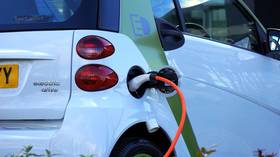Electric cars will kill oil demand within decade, Bank of America predicts

Bank of America Merill Lynch sees a peak in global demand for crude oil around 2030, followed by a period of rapid decline as a result of the electrification of transportation.
For the next decade or so, oil demand should continue to grow, although at a slower and slower rate. According to Bank of America Merrill Lynch, the annual increase in global oil consumption slows dramatically in the years ahead. By 2024, demand growth halves, falling to just 0.6 million barrels per day (mb/d), down from 1.2 mb/d this year.
But by 2030, demand growth zeros out as consumption hits a permanent peak, before falling at a relatively rapid rate thereafter.
The main driver of the destruction in demand is the proliferation of electric vehicles.
Also on rt.com Is this the world's most beautiful electric car?Bank of America did offer a few caveats and uncertainties. The growth of EVs hinges on a handful of key metals. Lithium, for instance, is mined and produced in large concentrations in a few Latin American countries.
But cobalt looms as a larger concern for some automakers. Roughly 62 percent global cobalt output is found in the Democratic Republic of Congo. An executive from Ford said recently that automakers might feel compelled to invest directly in cobalt production over fears of securing adequate supply. “I fully anticipate we’re going to keep a lot of pressure on that cobalt production,” Ted Miller, head of energy storage strategy and research at Ford, said at a mining event in South Africa. “Today it looks feasible but it’s a scenario we’re going to have to watch.”
The DRC just held a divisive election, and although the transfer of power has been mostly peaceful, the country has historically suffered from political instability. “Any major disruption to cobalt today would likely curb EV proliferation in the early 2020s, in turn supporting long dated crude oil prices,” Bank of America Merrill Lynch warned.
Also on rt.com Global outages boost oil pricesThere are alternatives to cobalt, but that would merely put pressure on other materials. “Car producers may gradually substitute from cobalt to nickel over the next two decades. In turn, this shift may lead to soaring demand for nickel, creating another supply squeeze as mine expansion plans are limited,” BofAML analysts wrote in their report.
There are a long list of other uncertainties that complicate such medium- and long-term forecasting. A brewing economic downturn, which may or may not hit in the next year or next few years, could linger into the 2020s. That would alter oil demand forecasts, but in complicated ways. Slower economic growth would put a dent in oil prices via lower demand, but a lower price itself could keep consumers hooked.
The EV market is also rife with uncertainty. EV sales are growing quickly, with the number of EVs on the roads picking up pace. Automakers are set to roll out dozens of new models, which will expand choice and awareness, while also making progress on price, range, and performance. Bank of America Merrill Lynch sees EVs having a “meaningful negative impact” on oil demand from 2021 onwards.
Also on rt.com China’s Tesla-killer ready to go public in New YorkThen, of course, there is the small matter of policy, which can cut both ways. Bank of America said that “the US's feeble commitments to climate action, fuel efficiency standards, and sulphur-limit reductions in shipping (IMO),” could slow EV adoption. But the next administration could also reverse course and step up climate ambition.
Even when breaking down oil demand into various segments, there is a lot of change going on. “EVs are shifting demand away from gasoline, IMO causes switching into diesel, and strong petchems demand growth is shifting demand toward the light part of the barrel, including NGLs in particular,” BofAML wrote. “We are at the beginning of a new age of uncertainty for oil producers, refiners and miners alike.”
Nevertheless, despite all of those uncertainties, the outlines of the trajectory are clear. Oil demand in the developed world saw a temporary boost over the last four years or so because of the collapse of oil prices. That has mostly run its course.
Demand “should return to outright declines as the price effect wears off and efficiency takes over,” BofAML wrote.
Also on rt.com ‘Eat it, Elon’: Internet greets Kalashnikov electric supercar with love & hate for old-school looksEmerging market demand should continue to grow as more people acquire cars. China, however, has made a major EV push and its demand growth is already starting to slow.
“The major driver of structural change in oil demand trends in the next five years and beyond is expected to be electric vehicles,” BofAML said. By 2020, EVs will capture 5 percent of global vehicle sales, which will balloon to 40 percent by 2030, before rising to 95 percent by 2050.
All of that implies a peak in oil demand by 2030, a little over a decade from now. We are in the midst of the “biggest structural shift in demand growth since the proliferation of the car began in the early 1900s,” BofAML concluded.
This article was originally published on Oilprice.com














